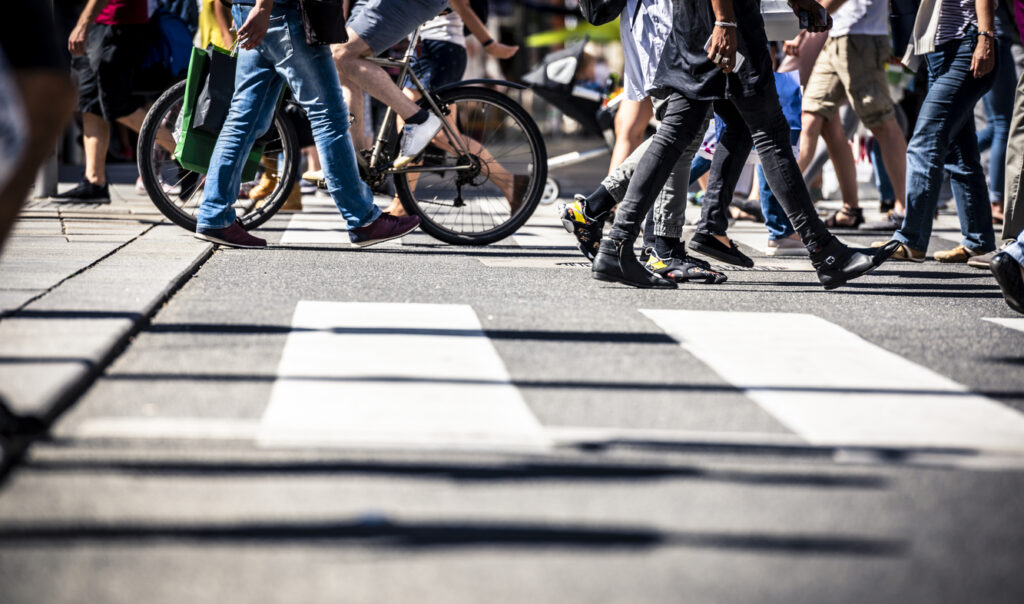Pedestrian accidents resulting in death in the USA have increased dramatically over the past dozen years, going up by 77% since 2010 and as a result, crossing the street is a lot more dangerous.
The roads were already getting deadlier for pedestrians before 2020, but the pandemic turbocharged the trend. In 2021, 7.624 pedestrians were killed. Between 2010 and 2021, the new GHSA report says, pedestrian fatalities increased by 77%. There’s no single explanation for why it’s getting more dangerous to walk on our roads, but there are a few major contributing factors. One is deadly road design. In the decades after World War 2, new communities emerged, centered on the premise that inhabitants would drive everywhere. Governments and regional planners designed wide, multi-lane arterial roads for high-speed travel. In the years since, traffic engineers and planners continued to widen those roads and add lanes, ostensibly to address congestion, while local officials approved commercial development alongside them. It led to what a former traffic engineer calls “stroads”.
In Marohn’s parlance, a street is a gathering place, where people can shop, dine, and live. It needs to be designed for pedestrians to be able to safely access the businesses around it, while a road is designed to move cars efficiently from point A to point B. A “stroad” is the worst of both worlds and is incredibly dangerous to pedestrians. The data bears this out: In 2021, the latest GHSA report says, 60.4 percent of pedestrian fatalities happened on such roads, which often lack the infrastructure that would make it safe for pedestrians, such as good lighting and frequent crosswalks. As a consequence, many of the people killed last year were struck at night.
There are some other factors at work as well:
Another major factor contributing to climbing pedestrian accidents resulting in fatalities is the American love affair with big vehicles. Over the past 20-plus years, US consumers have turned away from the small cars that used to dominate our roadways in favor of increasingly larger SUVs and light trucks. These larger, heavier vehicles create big blind spots and are more deadly to pedestrians when they strike them, especially children. From 2000 to 2019, smaller vehicles such as sedans dropped from 60% of all vehicles to around 40%, while the number of SUVs surged, from 10% to over 30%. In 2021, trucks and SUVs made up more than 80% of new vehicle sales, and there’s little sign of that trend abating, now that auto manufacturers are increasingly turning their production efforts toward more profitable luxury vehicles. Electric vehicles, being boosted by manufacturers and policymakers as the environmentally friendly future of automotive travel, are also significantly heavier than their gas-powered counterparts.
Other potential factors are harder to prove but would probably make sense to anyone who’s almost been run over in a crosswalk the last few years: One theory is that the pandemic, which saw more people staying at home and upended the usual traffic patterns, encouraged drivers to behave more recklessly because the roads were emptier. Another is the turmoil of the pandemic, plus political and social unrest in 2020, which led to the fraying of the social contract, with people, including drivers, acting more aggressively and unpredictably in public settings. A third is that the police, in response to the Black Lives Matter protests and other critiques of law enforcement, have largely given up on enforcing road safety, leading drivers to reasonably assume that they can drive dangerously without facing consequences.
Something else that seems plausible is that the ubiquity of smartphones, texting, and social media is leading to a lot more distracted drivers and pedestrians.
This is all part of a larger pattern, in which after many decades of getting safer, driving in the USA has started to get quite a bit more dangerous. Annual traffic deaths, which peaked around 55K per year in the early 1970s, had declined to about 33K per year in 2010 but were up to 46K per year in 2021. The city of St George, Utah has taken steps to mitigate the “frogger” approach to crossing streets. Especially the intersections near Utah Tech. If you are the victim of a pedestrian related accident, contact Injury Smart Law for a Free Consultation.


